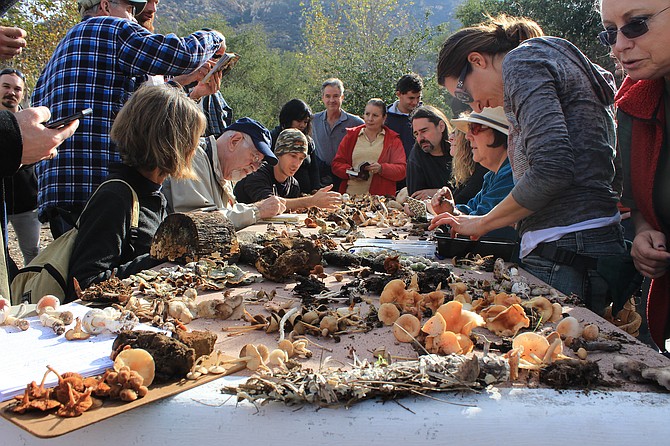 Facebook
Facebook
 X
X
 Instagram
Instagram
 TikTok
TikTok
 Youtube
Youtube

The mushroom: a symbol of ecological renewal, of alternative medicine, of psychedelic exploration. I see them everywhere these days: on clothing and murals and stickers, in cultivation kits that I can buy at my kids’ school, and in the documentary section of Netflix (Fantastic Fungi, 2019).
Here in San Diego, the love of mushrooms has had a home for more than two decades in the San Diego Mycological Society, created by founder Elio Schaecter and a small group of enthusiasts. Pat Nolan, a 24 year veteran of the club, says that “mushrooms have become the ‘in thing,’” but that she and the group have been here since “before the mushroom boom.” For Pat, a retired plant pathologist, a long-time engagement with fungal plant pathogens led to an interest in other fungi that she has been able to pursue in the club with like-minded people, people like Cassandra Ablola, the club’s current president, who says that she has “always loved mushrooms.” Her “first memory of loving mushrooms was Campbell’s mushroom soup,” and it only grew from there. She sees fungi with her artist’s eye; not everyone would call the microscopic forms of a mold “so pretty.” (While mushrooms may have a certain pride of place in the group, her comment about mold reminds me that fungus is a category that is broader than just mushrooms, encompassing “gazillions of molds” and — most importantly, in my estimation — the delicious truffle.)

There are many different angles from which people find mycological matters interesting: the club supports those with culinary interests, as well as cultivators and foragers of mushrooms, and even dye-makers. Cassandra makes little ceramic mushroom art. The group has assisted its members in learning about mycoremediation — the mushroom-fueled decontamination of environments — as well as building with mushroom-based materials. Their 24th annual Fungus Fair happened on February 27th; it brought in an impressive 80 new members. Pat also gave a talk on March 7 about Plant Pathology and Mycology. Events in the near future include a movie screening in Encinitas of Psychedelia: the History and Science of Mystical Experience, and a members-only “Mushroom Mixer” at a local meadery that will feature appetizers from the club’s chef.
Both Cassandra and Pat tell me that the social element of the group is of primary importance to them. They like the potlucks, meeting new people, being outside together on forays, and spending time with people who share their interest. Learning, camaraderie, and delight in the natural world, all growing together. Meetings are open to the public and take place on the first Monday of each month.


The mushroom: a symbol of ecological renewal, of alternative medicine, of psychedelic exploration. I see them everywhere these days: on clothing and murals and stickers, in cultivation kits that I can buy at my kids’ school, and in the documentary section of Netflix (Fantastic Fungi, 2019).
Here in San Diego, the love of mushrooms has had a home for more than two decades in the San Diego Mycological Society, created by founder Elio Schaecter and a small group of enthusiasts. Pat Nolan, a 24 year veteran of the club, says that “mushrooms have become the ‘in thing,’” but that she and the group have been here since “before the mushroom boom.” For Pat, a retired plant pathologist, a long-time engagement with fungal plant pathogens led to an interest in other fungi that she has been able to pursue in the club with like-minded people, people like Cassandra Ablola, the club’s current president, who says that she has “always loved mushrooms.” Her “first memory of loving mushrooms was Campbell’s mushroom soup,” and it only grew from there. She sees fungi with her artist’s eye; not everyone would call the microscopic forms of a mold “so pretty.” (While mushrooms may have a certain pride of place in the group, her comment about mold reminds me that fungus is a category that is broader than just mushrooms, encompassing “gazillions of molds” and — most importantly, in my estimation — the delicious truffle.)

There are many different angles from which people find mycological matters interesting: the club supports those with culinary interests, as well as cultivators and foragers of mushrooms, and even dye-makers. Cassandra makes little ceramic mushroom art. The group has assisted its members in learning about mycoremediation — the mushroom-fueled decontamination of environments — as well as building with mushroom-based materials. Their 24th annual Fungus Fair happened on February 27th; it brought in an impressive 80 new members. Pat also gave a talk on March 7 about Plant Pathology and Mycology. Events in the near future include a movie screening in Encinitas of Psychedelia: the History and Science of Mystical Experience, and a members-only “Mushroom Mixer” at a local meadery that will feature appetizers from the club’s chef.
Both Cassandra and Pat tell me that the social element of the group is of primary importance to them. They like the potlucks, meeting new people, being outside together on forays, and spending time with people who share their interest. Learning, camaraderie, and delight in the natural world, all growing together. Meetings are open to the public and take place on the first Monday of each month.
Comments